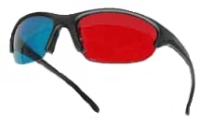3-D was one of the hottest topics for the second day of the 2009 NAB Convention. The Cinema world is convinced that 3-D (Stereoscopy) is the saviour of the Cinema industry by the much higher 'box office' receipts for 3-D versions of movies .
| Report on 3-D technologies
For television, the SMPTE has recently published its eagerly awaited report on options for bringing 3D Stereoscopic TV into the home. The report is largely a description of 'use cases' and the requirements for 3D TV systems for each of them.
This report is being digested by the broadcasting world, but at the same time, there are voices at NAB warning that even with the most carefully aligned stereoscopic TV system, there may be eyestrain if the pictures are watched for a prolonged period. We are still at the stage where eyestrain could be a problem. NBC reported no eyestrain for its short advertisements, but a definite tendency for eyestrain for a (carefully made) one hour 3D comedy show. | Rosy or blue future for 3-D?
|
Pass me my shades ...
The options for bringing 3-D to the broadcast world include different kinds of arrangements for switching the left and right eye displayed pictures to each eye, using different kinds of glasses.
One method is to provide left and right eye pictures as complementary colour pictures superimposed on each other ('anaglyph') together with red-cyan glasses. Voices at NAB agreed that although this is the easiest to transmit, it is the worst system from a picture quality point of view. It is nevertheless being used today for DVD and blu ray 3-D. For the transmission channel itself, the left and right eye signal could transmitted separately or in a combined way, or a single picture could be transmitted with a additionnal 'depth map'. Each approach has its own advantages.
Will it fly?
Most speakers agreed that there are two large barriers to the success of 3D TV. The first is the fact that unless much care is taken in making a 3D programme, and in the choice of technical system, the public will be 'turned off' HDTV. As one speaker said: "the water will easily be poissoned". The second is the fact that there is a large number of different technical systems, and some of them have already been sold to the public. At some stage, the penny will drop with the public that they will need lots of different receivers to be able to watch anything but a small number of 3D TV programmes. In other words, there was a real cry for standardisation of broadcast delivery of stereoscopic TV. Let's hope someone was listening.

